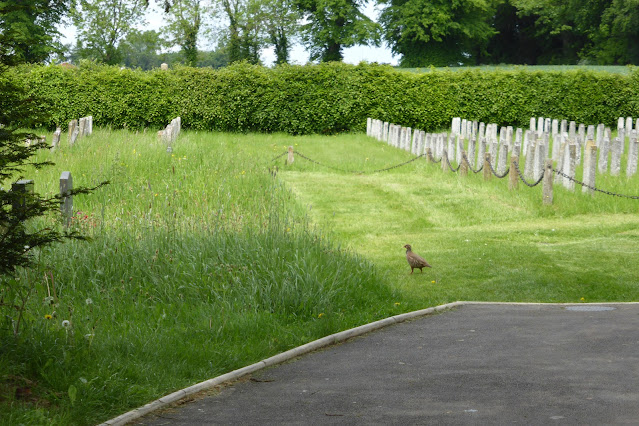An Ox-eye Daisy's view of people entering St John's Church Sharow
 |
| A Rough Hawkbit's view of people entering St John's Church Sharow |
Why are they here?
To explore the churchyard.
It is the beginning of Churches Count on Nature Week.
At Sharow
Sat 5th (World Environment Day) is aimed at families and at people who would like to know more about management of churchyards - - both for Bereavement Care and for Wildlife (see video lower down - still to be added)
Wednesday 9th is aimed at people who would like to help record wildlife - plants - birds- insects- lichens- fungi - whatever-
(But both types of people are welcome on both days)
Sharow Churchyard, is close to the lower stretches of the river Ure, and the soil is on the gravels left by the glaciers and river. The surrounding fields have been made into huge fields to grow lots of wheat, but the churchyard itself has some of the same meadow plants that grew here 200 years ago when the church was built.
Jill finds a baby Blue Tit that must have fallen out of its nest. She goes off to look for the nest
 |
 |
| Peter the Church Warden and Churchyard expert (left) and Revd Ruth Newton, the Vicar (pink jumper, rightish) lead a guided walk round the churchyard. We see how different mowing regimes are applied to different parts of the churchyard. Several people/groups have come from churches in different parts of Yorkshire to see how the churchyard is managed. Read a little here on the church website Emma from Nosterfield Nature Reserve is keen to learn what grasses we can find - It is great to have someone so enthusiastic. Here is one - Barren Brome - Anisantha sterilis we missed whilst we were together - maybe we will see it again on Wednesday: Altogether I record 18 grasses - 6 of which are not on their list: but I also fail to find five more grasses which are. Perhaps I will find these other five on Wednesday. I am specially interested to see how many "Hay Meadow Indicator Species" I can find - these are plants that are on a list that the Nature Conservancy Council and The Yorkshire Dales National Park wrote for surveying Dales Hay Meadows. One very good and beautiful example is Meadow Saxifrage- which is in the churchyard, but just going over: |
 |
| Meadow Saxifrage |
 |
| Another is Pignut |
 |












No comments:
Post a Comment